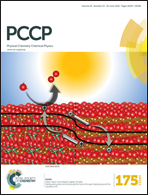Understanding M–ligand bonding and mer-/fac-isomerism in tris(8-hydroxyquinolinate) metallic complexes†
Abstract
Tris(8-hydroxyquinolinate) metallic complexes, Mq3, are one of the most important classes of organic semiconductor materials. Herein, the nature of the chemical bond in Mq3 complexes and its implications on their molecular properties were investigated by a combined experimental and computational approach. Various Mq3 complexes, resulting from the alteration of the metal and substitution of the 8-hydroxyquinoline ligand in different positions, were prepared. The mer-/fac-isomerism in Mq3 was explored by FTIR and NMR spectroscopy, evidencing that, irrespective of the substituent, mer- and fac-are the most stable molecular configurations of Al(III) and In(III) complexes, respectively. The relative M–ligand bond dissociation energies were evaluated experimentally by electrospray ionization tandem mass spectrometry (ESI-MS-MS), showing a non-monotonous variation along the group (Al > In > Ga). The results reveal a strong covalent character in M–ligand bonding, which allows for through-ligand electron delocalization, and explain the preferred molecular structures of Mq3 complexes as resulting from the interplay between bonding and steric factors. The mer-isomer reduces intraligand repulsions, being preferred for smaller metals, while the fac-isomer is favoured for larger metals where stronger covalent M–ligand bonds can be formed due to more extensive through-ligand conjugation mediated by metal “d” orbitals.



 Please wait while we load your content...
Please wait while we load your content...